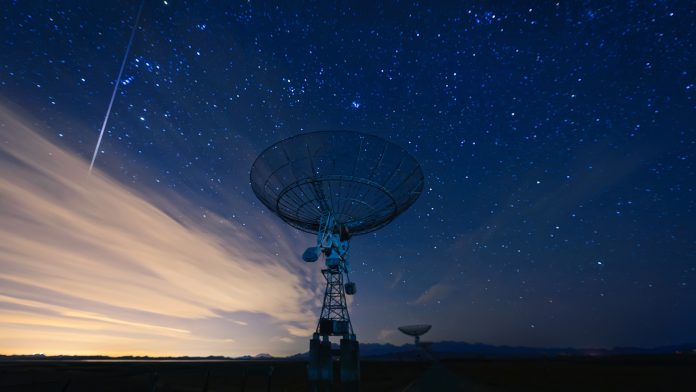Researchers from McGill University, in collaboration with other institutions, have detected a persistent and fast radio burst from a distant galaxy.
The astronomers have discovered a fast radio burst from a distant galaxy that seems to be flashing with unexpected consistency. This fast radio burst (FRB) has a signal that continues for up to three seconds, which is approximately 1,000 times longer than the typical FRB. Within this time frame, the researchers were able to detect frequent bursts of radio waves that repeated every 0.2 seconds in a clear periodic pattern.
Detecting the longest-lasting fast radio burst
The research collaboration has named the signal FRB 20191221A. At present, it is the longest-lasting fast radio burst, with the clearest periodic pattern. This novel breakthrough has been documented in Nature journal and was written by members of the CHIME/FRB collaboration.
In December 2019, the CHIME telescope detected the signal of a prospective FRB, which instantly attracted the attention of Daniele Michilli, who observed the abnormality while examining the incoming data.
“Not only was it very long, lasting about three seconds, but there were periodic peaks that were remarkably precise, emitting every fraction of a second — boom, boom, boom — like a heartbeat,” explained Michilli, who led the research, initially while at McGill University. “This is the first time the signal itself is periodic.”
“There are not many things in the Universe that emit strictly periodic signals,” added Aaron Pearlman, a FRQNT postdoctoral fellow at the McGill Space Institute who also collaborated on the paper. “Examples that we know of in our own Galaxy are radio pulsars and magnetars, which rotate and produce a beamed emission similar to a lighthouse. And we think this new signal could be a magnetar or pulsar on steroids.”
Tracking the expansion of the Universe
The astronomers are hopeful that they will be able to identify more periodic signals from this source, which could possibly be utilised as an astrophysical clock. For example, the regularity of the bursts, and how they adjust as the source moves away from Earth, may be employed as a way of calculating the rate at which the Universe is expanding.
In evaluating the pattern of FRB 20191221A’s radio bursts, Michilli and his colleagues discovered parallels with emissions from radio pulsars and magnetars in our own galaxy. Radio pulsars are neutron stars that emit beams of radio waves, seeming to pulse as the star rotates, while a comparable emission is generated by magnetars as a result of their extreme magnetic fields.
Emitting a train of brilliant bursts
The primary distinction between the new signal and radio emissions from our own galactic pulsars and magnetars is that FRB 20191221A seems to be approximately a million times brighter. According to Michilli, these luminous flashes may possibly derive from a distant radio pulsar or magnetar that is typically less bright as it rotates and, for an unidentified reason, ejected a train of brilliant bursts in a rare three-second window that CHIME was coincidentally situated to observe.
“CHIME has now detected many FRBs with different properties,” Michilli said. “We have seen some that live inside clouds that are very turbulent, while others look like they are in clean environments.
“From the properties of this new signal, we can say that around this source, there is a cloud of plasma that must be extremely turbulent.”
The team is hoping to observe additional bursts from the periodic FRB 20191221A, which can help to refine their understanding of its source, and of neutron stars in general.
“This detection raises the question of what could cause this extreme signal that we have never seen before, and how we can use this signal to study the Universe,” Michilli concluded. “Future telescopes promise to discover thousands of FRBs a month, and at that point we may find many more of these periodic signals.”









